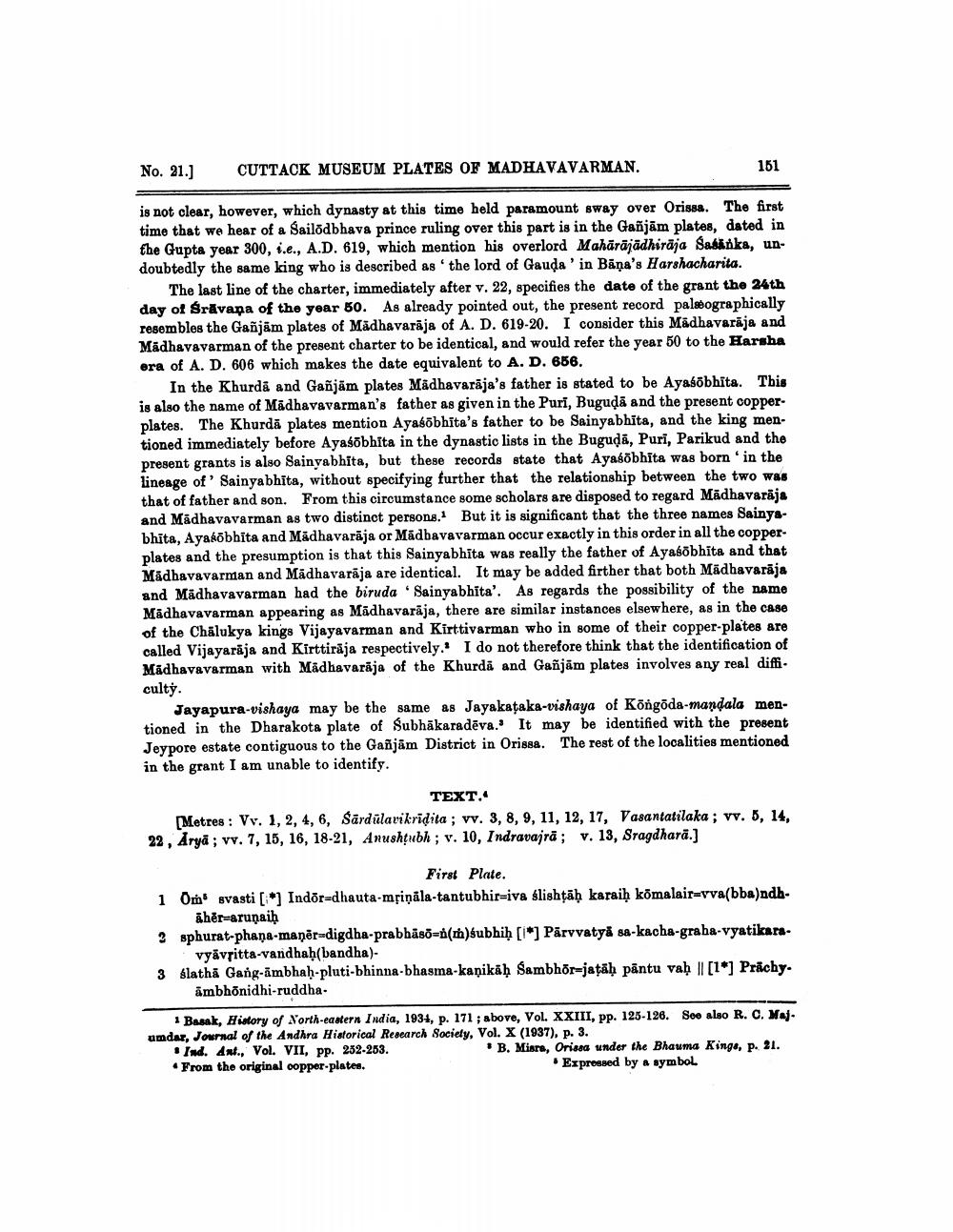________________
No. 21.)
CUTTACK MUSEUM PLATES OF MADHAVAVARMAN.
161
is not clear, however, which dynasty at this time held paramount sway over Orissa. The first time that we hear of a Sailodbhava prince ruling over this part is in the Gañjām plates, dated in the Gupta year 300, i.e., A.D. 619, which mention his overlord Mahārājādhiraja Sasanka, undoubtedly the same king who is described as the lord of Gauda' in Bāņa's Harshacharita.
The last line of the charter, immediately after v. 22, specifies the date of the grant the 24th day of Srāvana of the year 60. As already pointed out, the present record paleographically resembles the Gañjām plates of Madhavarāja of A. D. 619-20. I consider this Mädhavarāja and Madhavavarman of the present charter to be identical, and would refer the year 50 to the Harsha era of A. D. 606 which makes the date equivalent to A. D. 656.
In the Khurdã and Gañjām plates Madhavarāja's father is stated to be Ayaśābhīta. This is also the name of Madhavavarman's father as given in the Puri, Bugudā and the present copperplates. The Khurdă plates mention Ayasobhita's father to be Sainyabhita, and the king mentioned immediately before Ayasobhita in the dynastic lists in the Buguda, Puri, Parikud and the present grants is also Sainyabhita, but these records state that Ayasobhīta was born in the lineage of ' Sainyabhita, without specifying further that the relationship between the two was that of father and son. From this circumstance some scholars are disposed to regard Madhavarāja and Madhavavarman as two distinct persons. But it is significant that the three names Sainyabhīta, Ayabobhita and Madhavarāja or Mädbavavarman occur exactly in this order in all the copperplates and the presumption is that this Sainyabhīta was really the father of Ayasobhita and that Madhavavarman and Madhavarāja are identical. It may be added firther that both Madhavarāja and Madhavavarman had the biruda · Sainyabhīta'. As regards the possibility of the name Mādhavavarman appearing as Mādhavarāja, there are similar instances elsewhere, as in the case of the Chalukya kings Vijayavarman and Kirttivarman who in some of their copper-plates are called Vijayaraja and Kirttirāja respectively. I do not therefore think that the identification of Madhavavarman with Madhavarāja of the Khurdã and Gañjām plates involves any real diffi. culty
Jayapura-vishaya may be the same as Jayakataka-vishaya of Köngöda-mandala mentioned in the Dharakota plate of Subhākaradēva.' It may be identified with the present Jeypore estate contiguous to the Gañjām District in Orissa. The rest of the localities mentioned in the grant I am unable to identify.
TEXT. Metres: Vv. 1, 2, 4, 6, Sārdūlavikridita ; vv. 3, 8, 9, 11, 12, 17, Vasantatilaka; vv. 5, 14, 22, Aryā; vv. 7, 15, 16, 18-21, Anushțubh ; v. 10, Indravajrā; v. 13, Sragdharā.]
First Plate 1 Om svasti[*] Indor=dhauta-mțiņāla-tantubhir=iva slishțāḥ karaiḥ kõmalair=vva(bba)ndh
Xhér-arunaiḥ 3 sphurat-phana-maņēr-digdha-prabhäsõ=1(h)śubhiḥ [i*] Pārvvatyå sa-kacha-graha-vyatikara
vyāvsitta-vandhaḥ(bandha)3 slatha Gang-āmbhaḥ-pluti bhinna-bhasma-kaņikāḥ Sambhor=jațāḥ pāntu vaḥ || [1*] Prächy.
ambhõnidhi-ruddha
1 Basak, History of North-eastern India, 1934, p. 171 ; above, Vol. XXIII, pp. 125-126. Soo also R. C. Maj. umdar, Journal of the Andhra Historical Research Society, Vol. X (1937), p. 3. . Ind. Ant., Vol. VII, pp. 252-263.
• B. Misra, Orissa under the Bhauma Kinga, p. 21. • From the original copper-plates.
. Expressed by a symbol




